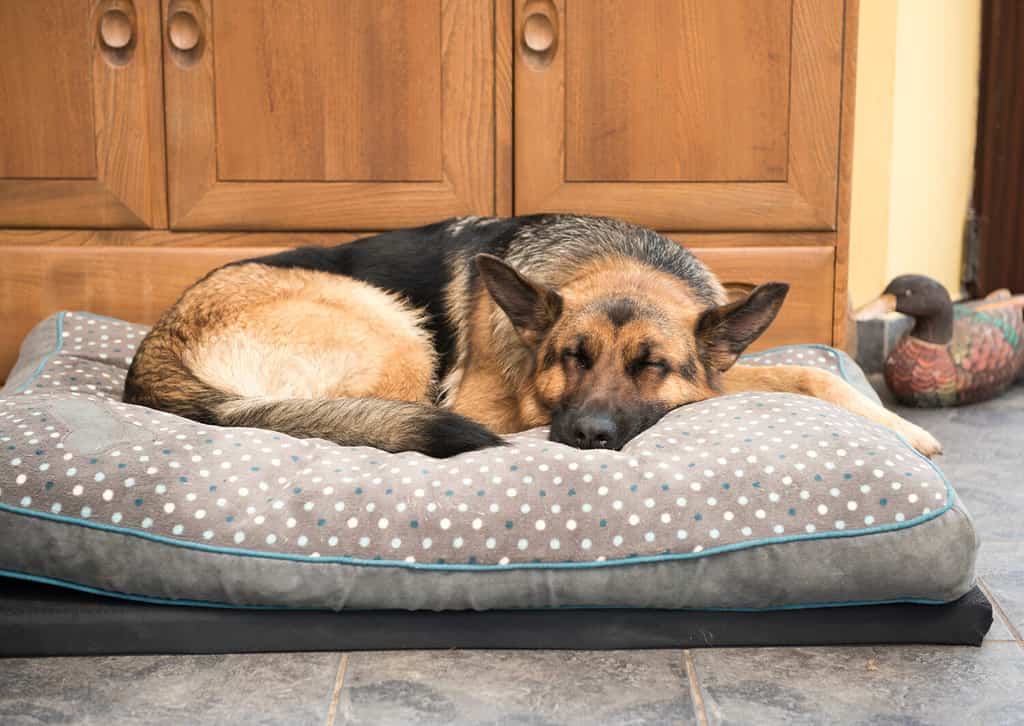
The post The Most Common Dog Sleeping Positions and What They Mean appeared first on A-Z Animals.
Sleepy dogs are so cute, whether they’re cuddled up with you or snoozing on their dog beds — or sprawled out in the middle of the floor. I love seeing my golden retriever sleeping after a fun day swimming or playing at the dog park. She’s just so snuggly and adorable! If you love watching your snoozing pup as much as I do, you may have noticed they don’t always sleep in the same positions. Sometimes they’re on their sides, and other times they’re just resting on their paws. It turns out, these different positions can signal different things about your dog’s comfort levels and personality.
“Dogs are masters of body language, and observing their preferred sleeping position can reveal a lot about their inner world,” Elam Miller, owner of The Dog Kennel Collection, tells A-Z Animals. Miller has worked closely with veterinarians to ensure his kennels provide the best possible rest for dogs. “You’ll see some positions more often than others as a consequence of both instinct and physiology,” he adds.
A-Z Animals chatted with Miller and Dr. Hyun Han, DVM, at TelaVets.com, a 24/7 telemedicine veterinary service, to find out what some of the most common dog sleeping positions are and what they mean.
Curled Up (the ‘Donut’)

They may be cold or in a tight place if they sleep curled up.
©Stephm2506/Shutterstock.com
“[This is] a protective position that conserves warmth,” Dr. Han tells A-Z Animals. “Common in wild canines, the Donut doesn’t mean your dog is stressed, just instinctive.”
“The curled-up position is by far the winner among the most common sleeping positions,” Miller says. “It makes tons of sense, too. Curling up allows your dog to conserve warmth to protect vital organs and to feel secure, like they would in a den. That’s why if your dog is in a crate or a kennel, where the space is or feels limited, they often default to this position.”
Side Sleeper
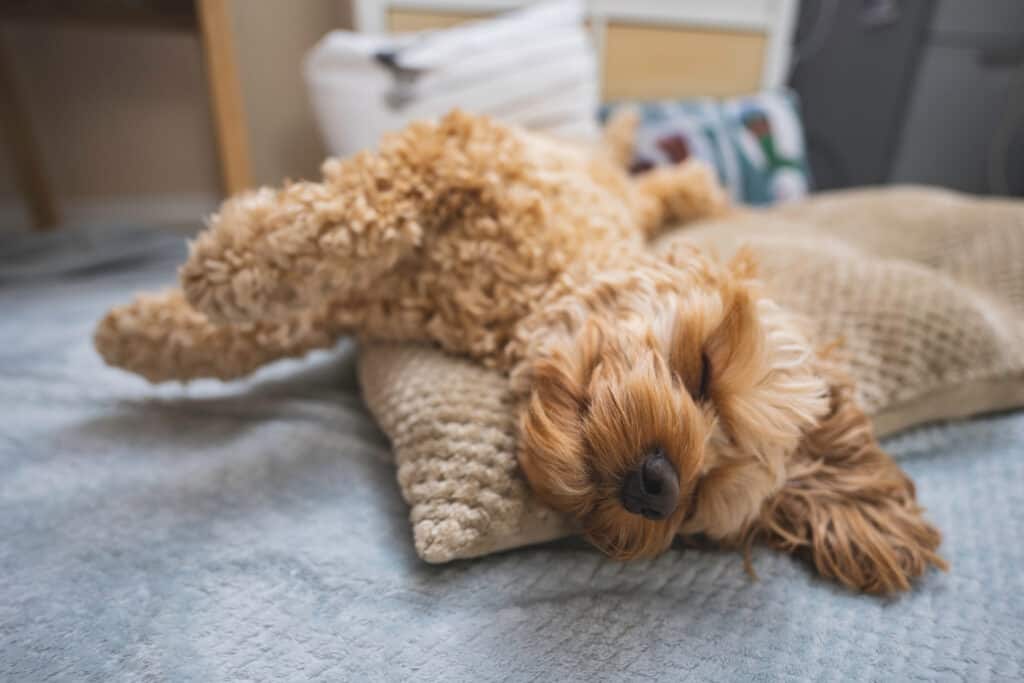
Like humans, dogs might sleep on their sides to be more comfortable.
©srw-photo/Shutterstock.com
“Shows comfort and relaxation,” Dr. Han says. “Dogs feel safe in their environment and are in a deep sleep.” Aww!
“The side sleeper is a sign that your dog feels safe and comfortable,” Miller explains. “The side sleeper is well known for its ability to facilitate REM sleep, which promotes neural growth and memory formation.”
Belly Up
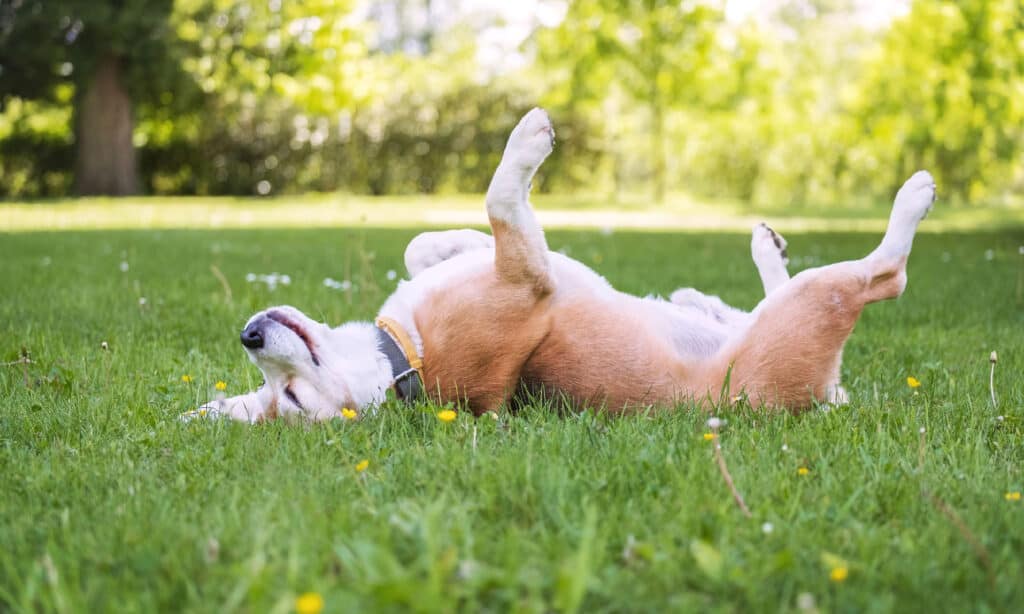
If you see your dog sleeping in this position, it’s a good sign!
©iStock.com/Solovyova
Dogs might lie on their backs for belly rubs, but if they fall asleep in this position, it means they definitely trust you! After all, it’s not a protective position.
“The ultimate sign of trust and comfort,” Dr. Han says. “This exposes their most vulnerable areas, so it’s a big vote of confidence in their surroundings. Also helps them cool down.”
Superman
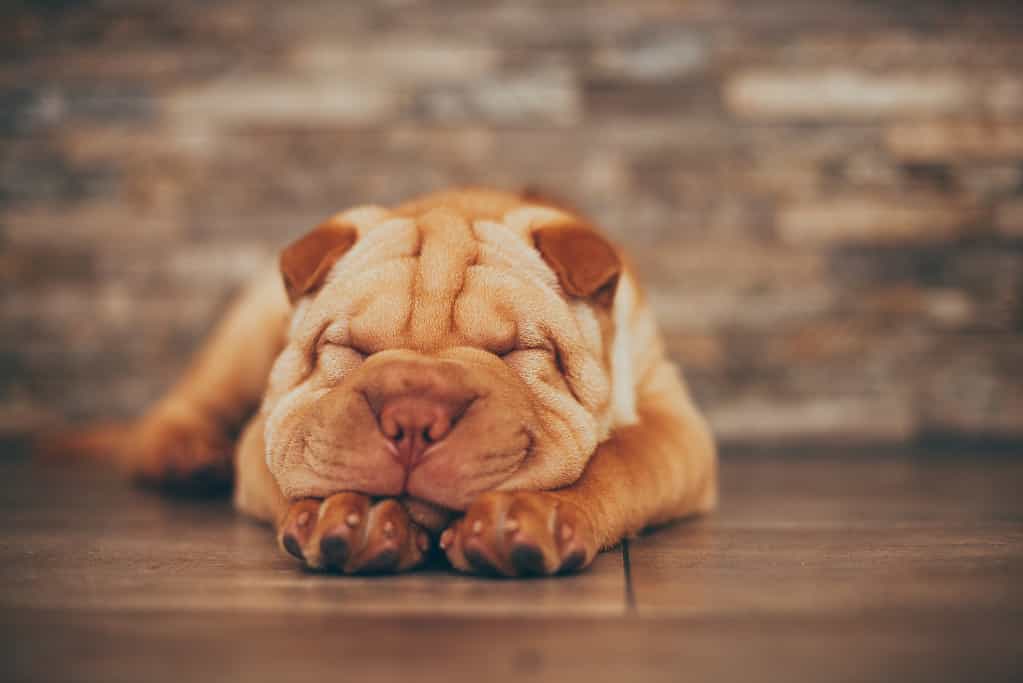
Sleeping stretched out like Superman is common in puppies.
©djiledesign/iStock via Getty Images
“For energetic breeds and puppies, you might notice a preference towards sleeping belly-down, commonly called the ‘Superman’ position,” Miller says. “It’s often a resting position in between play, allowing for a quick continuation.”
“More common in puppies,” says Dr. Han. “It’s a position that lets them rest but quickly jump back up for play.”
Back-to-Back
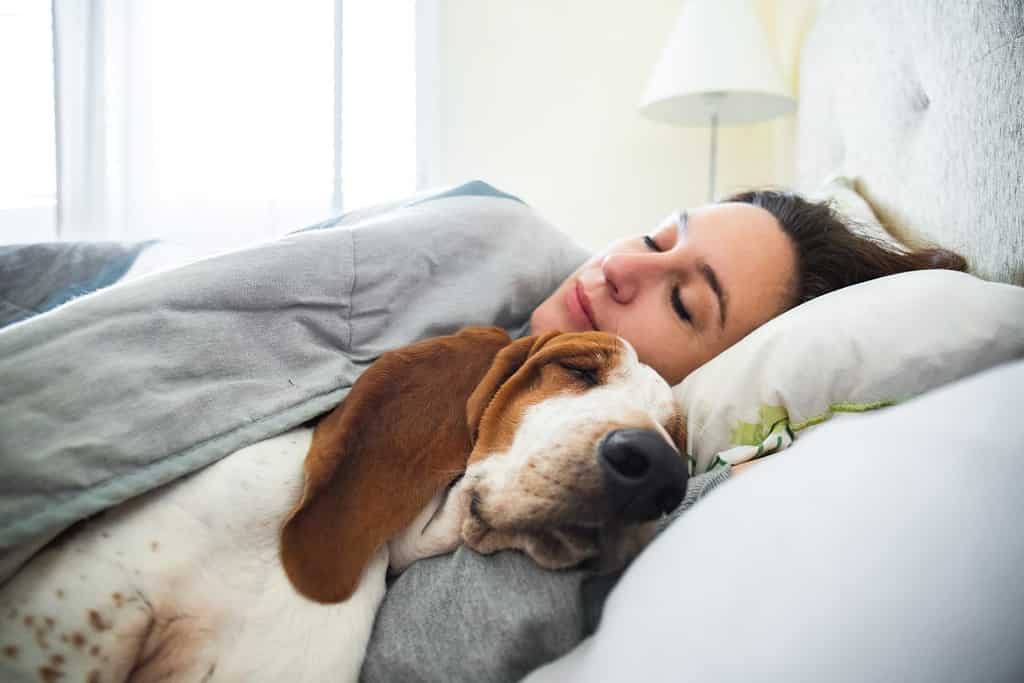
Snuggling dogs just want to bond with you.
©Daniel Myjones/Shutterstock.com
Is your dog a cuddler? This sleeping position means they feel safe with you.
“Shows bonding and affection,” Dr. Han says. “In the wild, dogs huddle for security and warmth.”
The ‘Sphinx’

If your dog is sleeping in this position, it means they are semi-alert.
©Maria Sidelnikova/Shutterstock.com
“You’ll notice many dogs sleeping in a head-on-paws resting position,” Miller explains. “It’s a common preference when the dog is dozing off, but wants to stay semi-alert. It’s a comfortable position that also allows them to stand up quickly if something catches their attention. From an evolutionary perspective, this position is perfect for survival since it enables rest without vulnerability.”
“A light doze position, almost like a ‘nap mode,’” Dr. Han agrees. “They’re resting but alert.”
Dogs are masters of body language, and observing their preferred sleeping position can reveal a lot about their inner world.
Elam Miller, owner of The Dog Kennel Collection
Sprawled Out
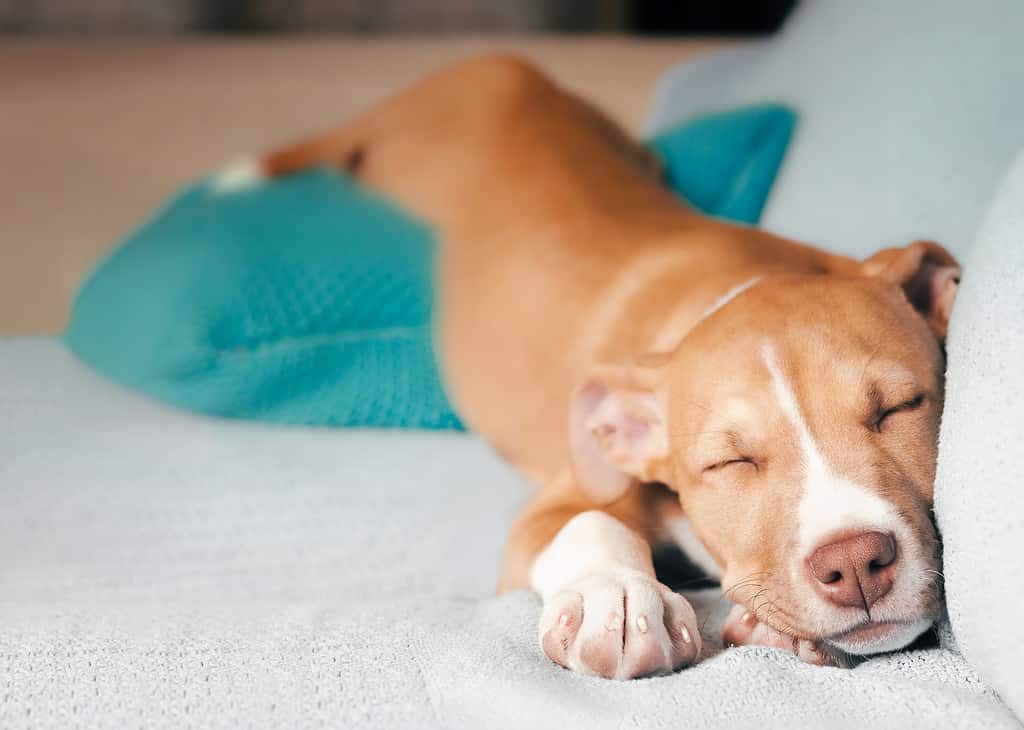
Dogs might spread out if they have the space.
©Petra Richli/iStock via Getty Images
Some dogs will just take up space anywhere they want! “This is often just about comfort and availability of space,” explains Dr. Han.
Different Preferred Sleeping Positions By Breed
Depending on the dog breed, external conditions, personality, and environment, dogs may develop different preferred sleeping positions.
Dr. Han says, “Brachycephalic breeds (like bulldogs, pugs) often prefer side or belly-up positions because of their airways.”
On the other hand, more active breeds may not fully relax in the same way. “Working and sporting breeds (labs, Shepherds) may rest in Sphinx or Superman positions because they’re ready for activity,” he says. The Sphinx is one of my perpetually active golden retriever’s favorite ways to lie, so that makes sense.
For small and toy breeds, they might get cold easily. “Small breeds often curl up to conserve heat,” Dr. Han explains.
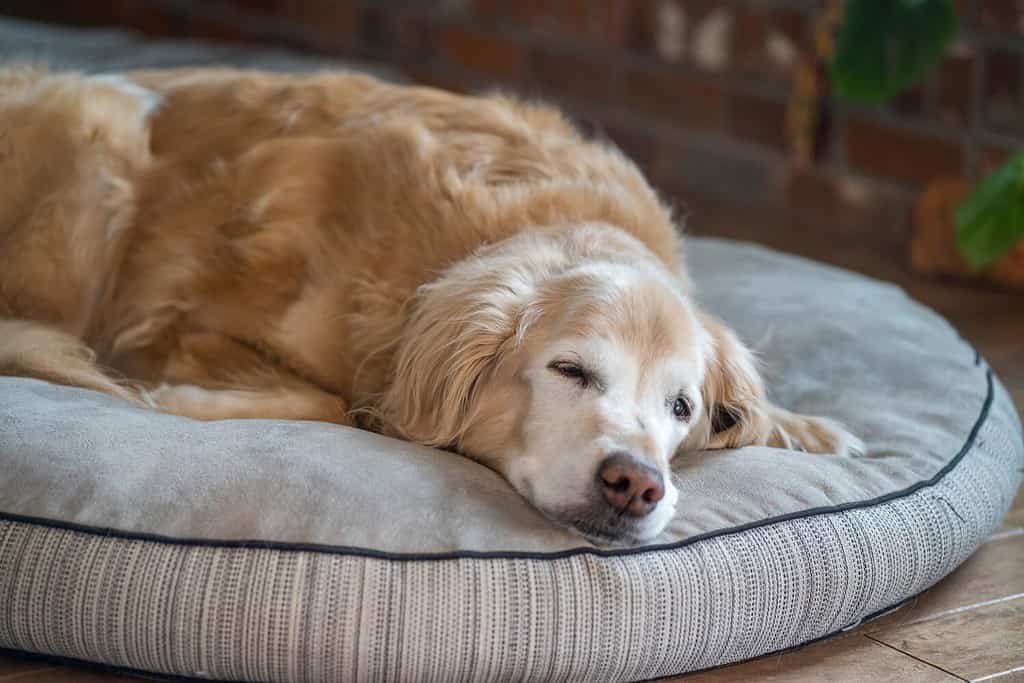
Sleeping on their paws is like sleeping with one eye open for active dogs.
©Yobab/Shutterstock.com
“Most dogs use multiple positions depending on comfort, age, and environment,” Dr. Han says, adding, “For example, seniors with joint issues often prefer side sleeping on supportive beds.”
“Smaller dogs prefer curling up because their small bodies release heat quickly,” Miller explains. “Larger dogs commonly sprawl because tight curls are less comfortable. Working dogs might develop a habit for ready-to-go positions.”
Speaking of the environment, where your dog is sleeping can influence its sleeping style.
“In crates, dogs tend to curl up more as space is limited and it feels den-like,” Dr. Han says. “In dog beds, positions vary. Orthopedic beds often encourage side or belly-up sleeping. Dogs may sprawl out more in human beds, since they mimic their owner’s relaxed body language and enjoy the extra space.”
What Else Can Sleeping Dogs Tell Us?
In general, owners don’t have to put too much stock into their dog’s sleeping position. It could be a sign of something worrisome, or it could just be comfortable for them.
“It’s a common misconception that a sleeping position is a confirmation of how your dog feels,” Miller says. “The reality is much more nuanced than that. A belly-up position can just be an attempt to cool off. Or a tight curl might be a sign of anxiety or even discomfort. Instead of simply reading the positions, you should look for context and patterns.”
So, if your dog’s sleeping position changes noticeably or seems unusual, that is a better indicator that something may be wrong than the specific position itself. Also, keep in mind that it’s normal for your dog’s preferred sleeping position to change.
“Position changes throughout the night are normal and healthy,” Dr. Han explains. “Extreme stiffness, restless shifting, or reluctance to lie in certain positions may signal pain, arthritis, or discomfort — worth a vet visit.”
How Much Sleep Do Dogs Need?

Puppies and older dogs typically need more sleep than adult dogs.
©Kuznetsov Alexey/Shutterstock.com
Sleep is essential to our health and our dog’s health. According to Dr. Han, dogs need about 12-14 hours of sleep a day, while puppies need up to 18-20 hours of sleep per 24 hours.
Dogs don’t get all that sleep at once, though. They tend to doze off throughout the day for naps when they are tired or bored, allowing them to wake up and spring to awareness quickly when they want to. Because of this, they only spend about 10-12% of their total sleep time in REM sleep, meaning they’ll have to sleep more to make up for it.
Additionally, bigger dogs, puppies, and senior dogs will sleep more than the average adult-sized dog. If you notice significant changes in your dog’s sleep, such as sleeping for an extended period or having difficulty waking up, talk to your vet, as this could be a sign that something is wrong.
The post The Most Common Dog Sleeping Positions and What They Mean appeared first on A-Z Animals.
September 17, 2025 at 06:02PMSydni Ellis
.jpeg)
.jpeg)

0 Comments